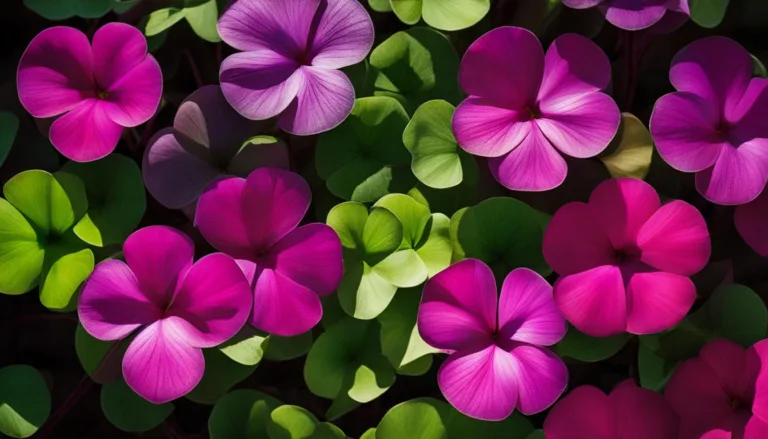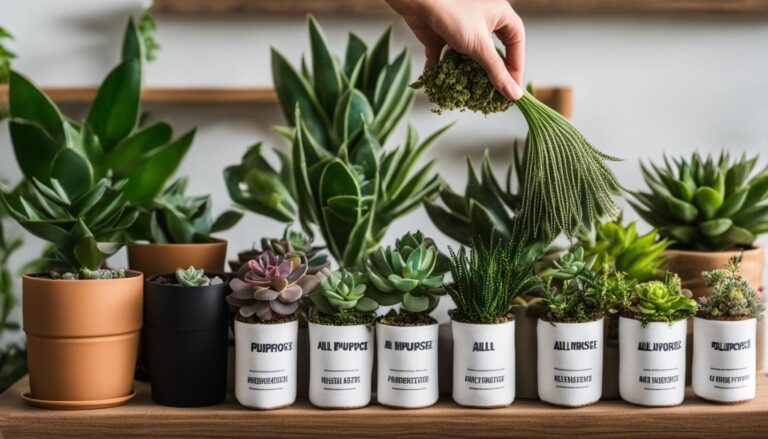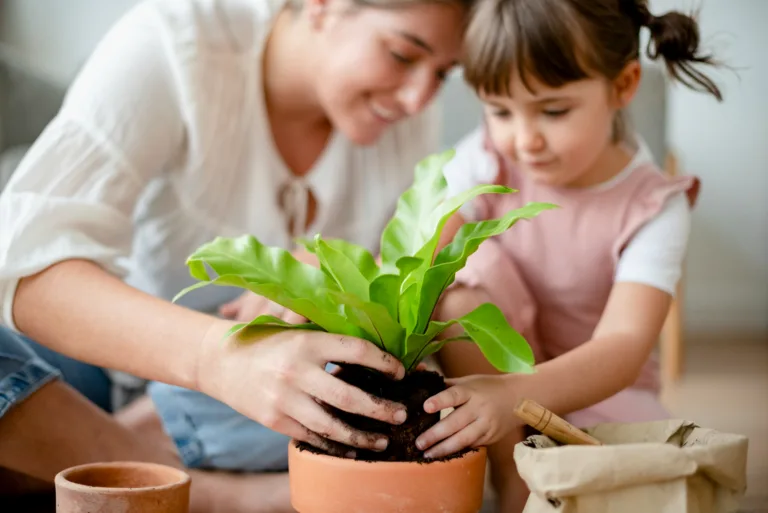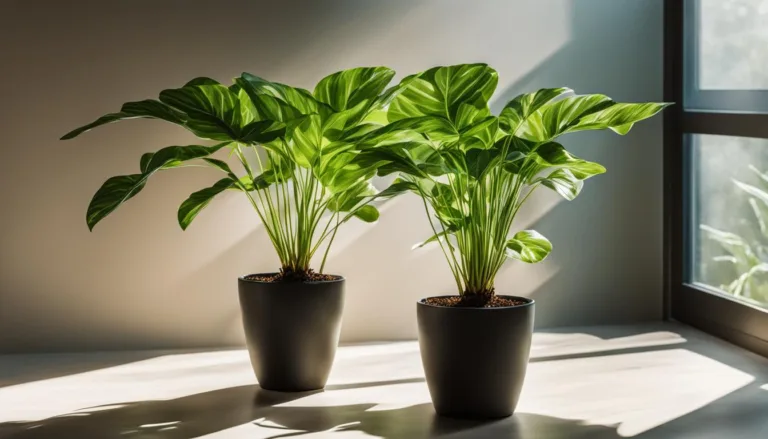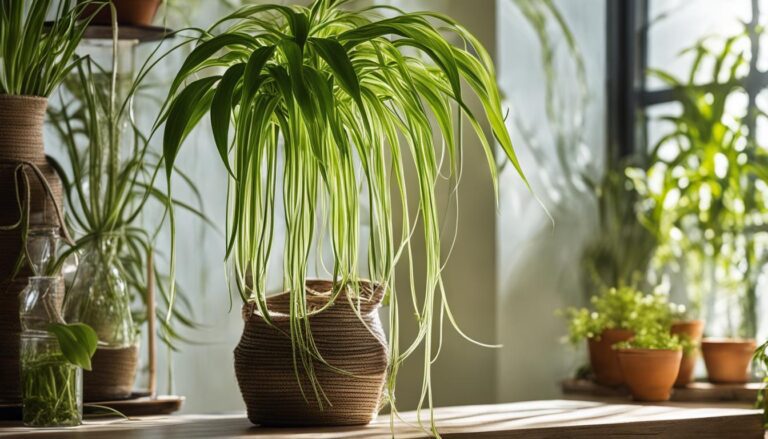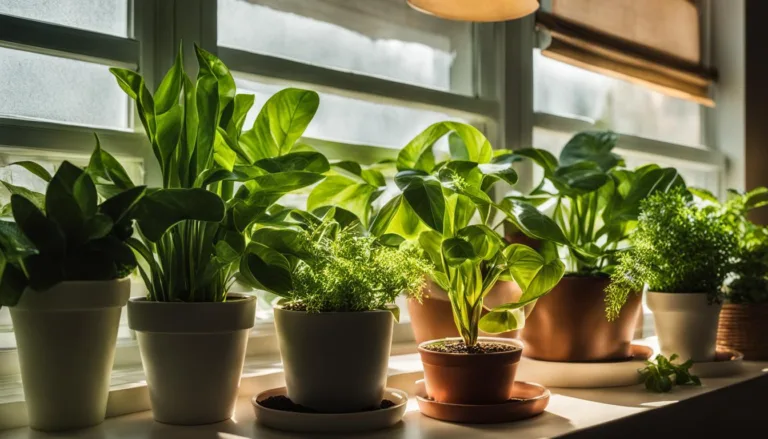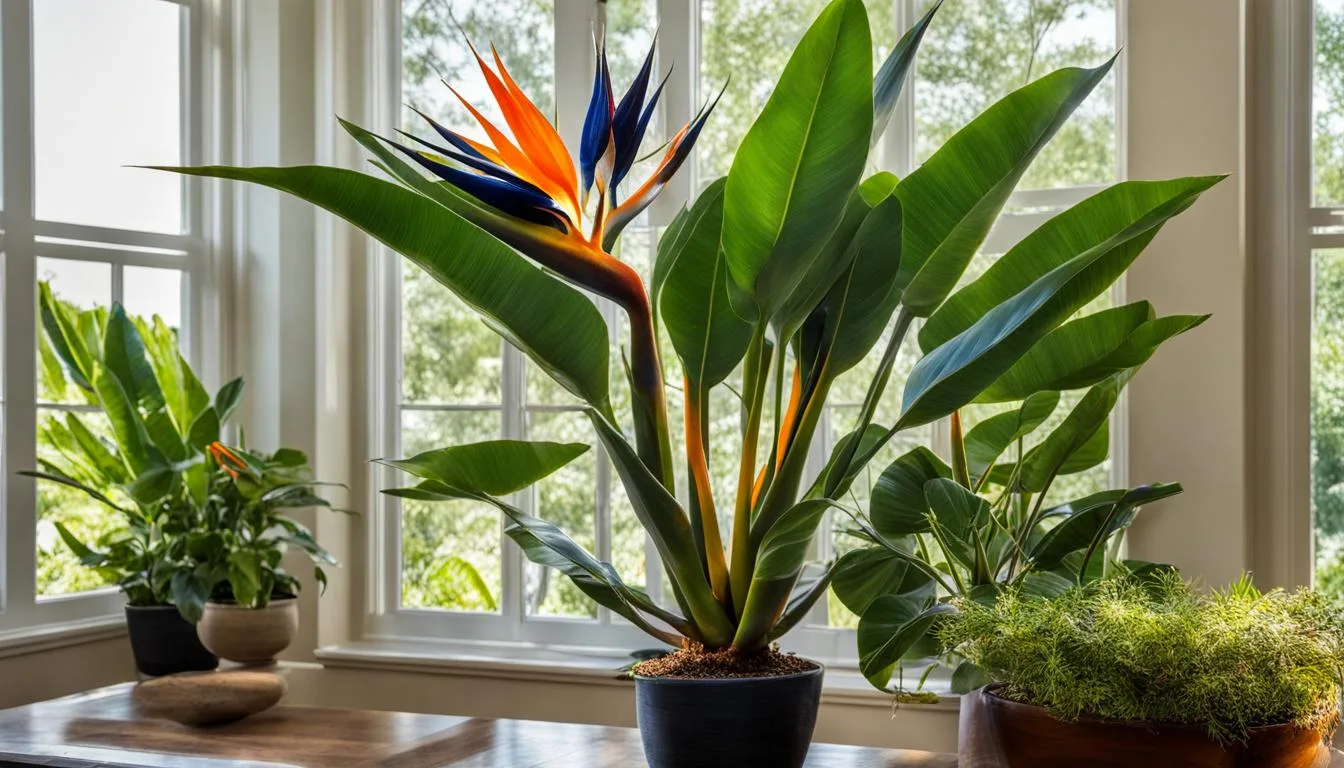
The Bird of Paradise (Strelitzia nicolai) is a stunning houseplant known for its tropical foliage and vibrant flowers. Caring for a Bird of Paradise plant requires attention to its specific needs to ensure its health and beauty. In this guide, I’ll provide you with essential tips and instructions on how to care for your Bird of Paradise plant.
Key Takeaways:
- Provide your Bird of Paradise plant with bright light to thrive.
- Water your plant every 1-2 weeks, allowing the soil to slightly dry out between waterings.
- Fertilize your plant monthly during the spring and fall seasons.
- Regularly prune older, drooping leaves to maintain a balanced appearance.
- Repot your Bird of Paradise plant every 18-24 months or when it becomes pot-bound.
Bird of Paradise Plant Placement
When it comes to the placement of your Bird of Paradise plant, it’s important to consider its sunlight needs and indoor location. These stunning tropical plants thrive in bright light, so it’s crucial to choose a location that receives at least four hours of southern, western, or eastern exposure. Avoid placing your Bird of Paradise in low light conditions as it may struggle to thrive.
Avoid placing your Bird of Paradise plant in direct sunlight, as this can cause the leaves to scorch. Instead, opt for bright indirect light or filtered sunlight. If your plant isn’t receiving enough light, you may notice stretched or pale leaves.
When selecting an indoor location for your Bird of Paradise, keep in mind that it needs ample space to grow. The large, broad leaves of the plant require room to spread out. Ensure that the location you choose allows for the plant to fully develop without any crowding or obstruction.
Sunlight Needs
Bird of Paradise plants require bright light to thrive. They prefer a minimum of four hours of direct or indirect sunlight per day. Placing the plant near a south, west, or east-facing window is ideal for providing adequate light. However, it’s important to avoid placing your Bird of Paradise in direct sunlight, as this can cause leaf burn.
Indoor Location
When choosing the indoor location for your Bird of Paradise plant, consider the size and shape of the plant. These plants can grow quite large, so ensure that the space you select allows for the plant to spread out its leaves without any crowding. Keep in mind that Bird of Paradise plants can tolerate medium light conditions, but they will thrive best in bright, indirect light.
Bird of Paradise Plant Watering Tips
Proper watering is essential for the health and vitality of your Bird of Paradise plant. Here are some tips to help you maintain the right moisture levels and ensure your plant thrives:
Determining the Watering Schedule
It’s important to establish a regular watering schedule for your Bird of Paradise plant. Watering every 1-2 weeks is generally sufficient, but the frequency may vary depending on factors such as humidity, temperature, and the size of the plant. To determine if your plant needs watering, check the moisture level in the soil.
Tip: To check the moisture level, insert your finger into the soil to a depth of 2-3 inches. If the soil feels dry at this depth, it’s time to water your Bird of Paradise plant.
Proper Watering Technique
When watering your Bird of Paradise plant, ensure thorough saturation of the soil. Water until you see it draining out from the bottom of the pot. This helps to flush out any accumulated salts or mineral deposits. However, be cautious not to overwater the plant as it can lead to root rot and other moisture-related issues.
Tip: Avoid letting the plant sit in standing water, as this can also cause root rot. Make sure the drainage holes in the pot are clear and allow excess water to escape.
Soil Moisture Requirements
Your Bird of Paradise plant prefers slightly moist soil. The top 2-3 inches of soil should dry out between waterings, but the soil below should remain moist. This balance ensures adequate hydration for the plant while preventing waterlogged conditions.
Tip: Consider using a moisture meter to accurately measure the soil moisture level. This can help you avoid guesswork and ensure you are watering your Bird of Paradise plant effectively.
| Watering Frequency | Signs of Underwatering | Signs of Overwatering |
|---|---|---|
| Every 1-2 weeks | – Wilting leaves – Dry soil – Leaf edges turning brown | – Yellowing leaves – Mushy roots – Foul odor |
Bird of Paradise Plant Fertilizing
Proper fertilizing is essential for the health and vitality of your Bird of Paradise plant. By providing the right nutrients, you can encourage lush growth and vibrant foliage. Here are some guidelines on how often to fertilize your Bird of Paradise plant to ensure optimal results.
Choosing the Right Fertilizer
When it comes to fertilizing your Bird of Paradise plant, it’s important to use the right type of fertilizer. Look for an organic, slow-release houseplant fertilizer that is specifically formulated for tropical plants. This will provide a balanced mix of nutrients and prevent the risk of over-fertilizing, which can damage the plant.
Fertilizing Frequency
In general, you should fertilize your Bird of Paradise plant once a month during the spring through fall seasons, which is the active growing period.
During the winter months, when the plant is in its dormant phase, reduce fertilization to every two months or stop altogether. Adjust the frequency based on the specific instructions provided with your chosen fertilizer.
It’s important not to over-fertilize your Bird of Paradise plant, as this can lead to salt build-up and burn the roots. Remember to dilute the fertilizer according to the package instructions and apply it to moist soil to avoid any potential damage.
| Fertilizing Frequency | Spring | Summer | Fall | Winter |
|---|---|---|---|---|
| Frequency | Once a month | Once a month | Once a month | Every two months or none |
By following these guidelines and providing your Bird of Paradise plant with regular fertilization, you can ensure its overall health and encourage optimal growth. Remember to always read and follow the specific instructions provided by the manufacturer of your chosen fertilizer for best results.
Key Points:
- Choose an organic, slow-release fertilizer specifically formulated for tropical plants.
- Fertilize your Bird of Paradise plant once a month during the spring through fall seasons.
- Reduce fertilization to every two months or stop altogether during the winter months.
- Read and follow the specific instructions provided with your chosen fertilizer.
Pruning
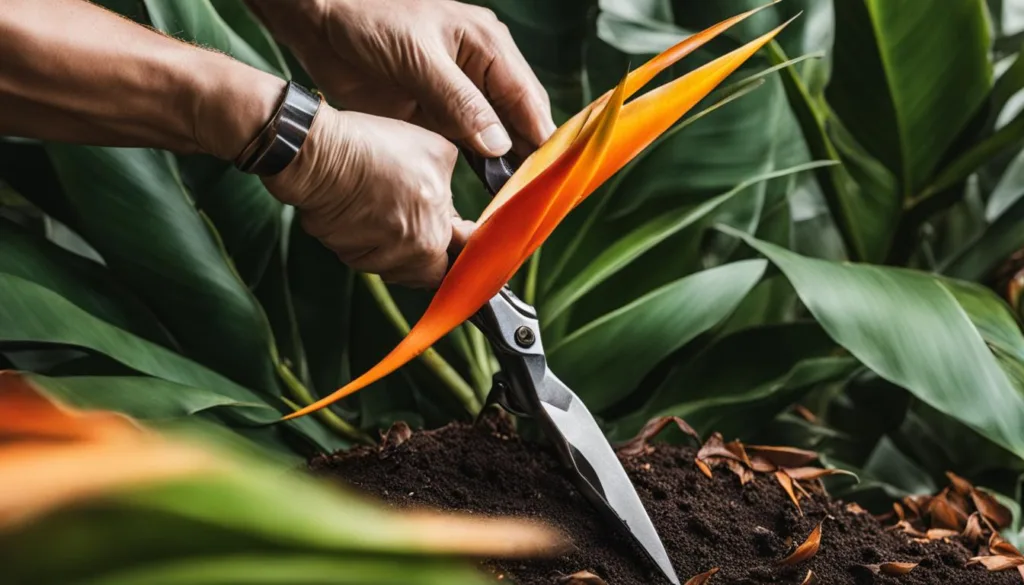
Pruning is an essential aspect of caring for your Bird of Paradise plant, as it helps maintain its appearance and overall health. By removing older leaves that may become droopy or develop splits, you can keep your plant looking full and balanced. Additionally, pruning discolored or broken leaves not only improves the aesthetics but also promotes better photosynthesis.
When pruning, use clean and sharp pruning shears or scissors to make precise cuts. Start by cutting the leaf stem at the base, close to the main stem of the plant.
It’s important to prune selectively and avoid removing too many leaves at once, as this can put stress on the plant. Instead, focus on removing only the leaves that are damaged or past their prime.
Regular dusting of the leaves is also recommended to prevent dust buildup, which can hinder the plant’s ability to absorb light. Simply use a soft cloth or a feather duster to gently wipe the leaves and keep them clean. This will ensure that your Bird of Paradise plant continues to thrive and maintain its vibrant foliage.
Benefits of Pruning
Pruning your Bird of Paradise plant has several benefits. It helps to:
- Promote healthy growth by redirecting nutrients to new leaves and flowers
- Prevent overcrowding and improve air circulation around the plant
- Maintain a balanced and attractive appearance
- Remove diseased or damaged leaves, preventing the spread of infection
By incorporating regular pruning into your plant care routine, you can ensure that your Bird of Paradise plant remains healthy and visually appealing for years to come.
Bird of Paradise Plant Repotting
Repotting your Bird of Paradise plant is an essential part of its care routine. By providing a larger container and fresh soil, you ensure that the plant has enough room for growth and access to nutrients. Here are some guidelines on when and how often to repot your Bird of Paradise plant.
When to Repot
The best time to repot your Bird of Paradise plant is every 18-24 months or when you notice that it has become slightly pot-bound. Signs that your plant needs repotting include roots growing out of the drainage holes, stunted growth, or the pot tipping over easily. Spring or summer is the ideal time to repot, as the plant is actively growing during this period.
How Often to Repot
On average, repotting your Bird of Paradise plant every 18-24 months is sufficient. However, it’s important to assess the root system and growth rate of your specific plant.
If your Bird of Paradise is growing rapidly or has become severely root-bound, you may need to repot it more frequently, potentially every 12-18 months. Conversely, if you prefer to maintain the current size of your plant, you can repot it into the same vessel with fresh soil and trimmed roots.
To repot your Bird of Paradise plant, choose a pot that is 2-4 inches larger in diameter than the current one. This will allow for sufficient room for the roots to spread out. Use a well-draining potting mix that retains moisture but doesn’t become waterlogged.
When repotting, gently loosen the root ball and remove any dead or damaged roots. Place the plant in the new pot and fill in the gaps with the fresh potting mix, ensuring that the plant is stable and upright.
| Signs that your Bird of Paradise plant needs repotting: | When to repot: | How often to repot: |
|---|---|---|
| Roots growing out of drainage holes | Every 18-24 months or when slightly pot-bound | On average, every 18-24 months |
| Stunted growth | Spring or summer | Depending on growth rate and root-boundness, potentially every 12-18 months |
| Pot tipping over easily |
Repotting your Bird of Paradise plant at the right time will promote healthy growth and ensure that it continues to thrive in its new container. By following these guidelines, you can provide the optimal conditions for your Bird of Paradise plant to flourish.
Bird of Paradise Plant Lighting Requirements
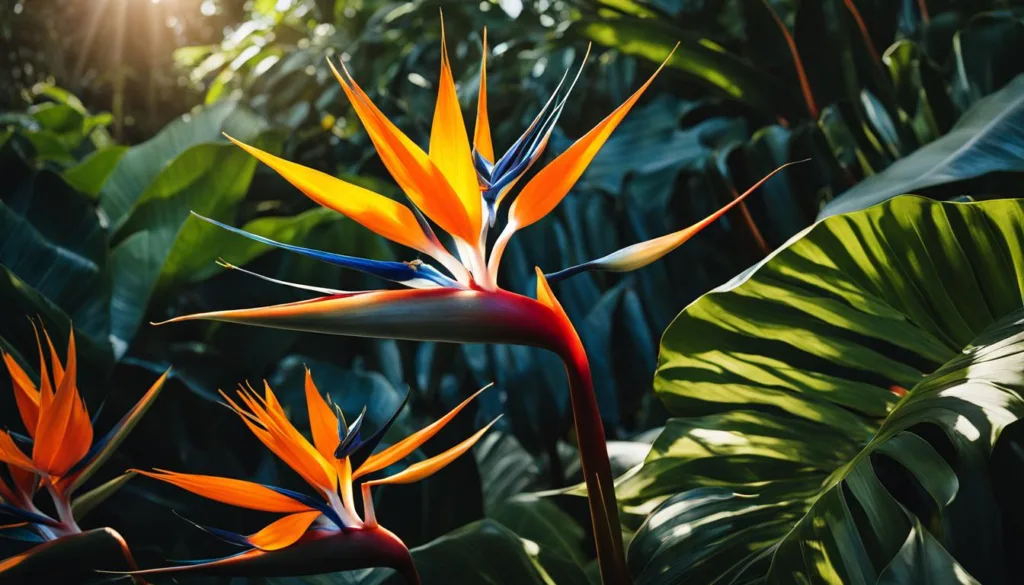
Proper lighting is essential for the health and growth of your Bird of Paradise plant. These tropical beauties thrive in bright, indirect light to full sun, making it important to provide them with adequate sunlight exposure. Let’s take a closer look at the light requirements for your Bird of Paradise plant.
Determining the Amount of Light
To ensure your Bird of Paradise plant receives the right amount of light, it’s essential to understand its needs. These plants require at least four hours of direct sunlight per day to grow and bloom properly.
If you’re growing them indoors, place them near a south, west, or east-facing window where they can receive ample sunlight. If direct sunlight is limited in your home, consider using artificial grow lights to supplement the natural light.
While Bird of Paradise plants prefer bright light, they can tolerate medium light conditions as well. However, it’s important to note that insufficient light may result in slower growth, pale leaves, or the plant failing to produce flowers.
Protecting Your Plant from Excessive Light
While Bird of Paradise plants thrive in bright light, too much direct sunlight can cause damage to their foliage. If your plant receives intense afternoon sunlight, it’s a good idea to provide some shade during the hottest part of the day. You can use a sheer curtain or move the plant to a slightly shadier location to protect it from excessive light exposure.
| Lighting Conditions | Sunlight Exposure |
|---|---|
| Full Sun | At least four hours of direct sunlight per day |
| Bright Indirect Light | Ample natural light without direct sun exposure |
| Medium Light | Lower light conditions, but still bright enough |
By understanding and providing the right lighting conditions for your Bird of Paradise plant, you can ensure its optimal growth and vibrant foliage. Remember to monitor the amount of light your plant receives and make any necessary adjustments to provide it with the ideal conditions for thriving.
Bird of Paradise Plant Humidity Needs
Proper humidity is essential for the health and well-being of your Bird of Paradise plant. While these plants prefer humid conditions, they can tolerate normal room humidity levels. However, if you want to provide the optimal environment for your plant, there are a few simple ways to increase indoor humidity.
One effective method is to use a fine-mist mister or a humidifier. Simply mist the leaves of your Bird of Paradise plant regularly or place a humidifier near the plant to add moisture to the air. This is especially beneficial during dry seasons or if you live in a region with low humidity.
If you don’t have a mister or humidifier, you can also create a DIY humidity tray. Fill a shallow tray with water and place pebbles or stones in the tray. Then, place your plant on top of the pebbles, making sure the water does not touch the bottom of the pot. As the water evaporates, it will increase the humidity around the plant.
Summary:
- Bird of Paradise plants prefer humid conditions, but normal room humidity will suffice.
- Use a fine-mist mister or humidifier to increase humidity levels.
- Create a DIY humidity tray by placing your plant on pebbles in a tray filled with water.
| Humidity Needs | Methods to Increase Humidity |
|---|---|
| Prefer humid conditions | Use a fine-mist mister or humidifier |
| Tolerate normal room humidity | Create a DIY humidity tray with water and pebbles |
Common Problems
Bird of Paradise plants (Strelitzia nicolai) are generally resilient and low-maintenance houseplants. However, like any other plant, they may encounter a few common problems. Being aware of these issues and knowing how to address them can help ensure the health and vitality of your Bird of Paradise plant.
Pests
One of the most common problems that Bird of Paradise plants may face is pest infestation. While these plants are generally pest-free, they can be prone to spider mites. These tiny pests can cause damage by sucking the sap from the plant’s leaves, resulting in yellowing, wilting, and the formation of spider-like webs.
To tackle spider mites, treat your Bird of Paradise plant with neem oil, which is an effective organic insecticide. Dilute the neem oil according to the package instructions and spray it onto the leaves, ensuring thorough coverage. In addition, regularly wipe down the plant’s leaves with a damp cloth to remove any pests or webs.
Leaf Splitting
Another common characteristic of Bird of Paradise plants is the natural splitting of their leaves. This splitting is actually a defense mechanism that helps the plant withstand strong winds in its native habitat. While it may appear concerning, leaf splitting is a normal occurrence and does not necessarily indicate any underlying issues with the plant’s health.
If you notice excessive leaf splitting or are concerned about the plant’s appearance, you can prune the damaged leaves to maintain a neat and tidy appearance. Regularly dusting the leaves can also aid in efficient photosynthesis and overall plant health.
| Common Problems | Pests | Leaf Splitting |
|---|---|---|
| Description | Prone to spider mites | Normal defense mechanism |
| Symptoms | Yellowing, wilting, spider-like webs | Natural splitting of leaves |
| Treatment | Neem oil, regular wiping of leaves | Pruning of damaged leaves |
Flowering
When it comes to flowering, Bird of Paradise plants can be a bit finicky indoors. These tropical beauties require high humidity and specific light conditions similar to their natural habitat to produce their stunning flowers. Due to these requirements, it’s not uncommon for Bird of Paradise plants to not flower indoors.
If you’re determined to see your Bird of Paradise plant bloom, there are a few things you can try. First, make sure your plant is receiving at least four hours of direct sunlight every day. This is crucial for promoting flower growth. Additionally, consider increasing the humidity levels around your plant.
You can do this by incorporating a fine-mist mister or a humidifier in the room where your plant is located. The added moisture in the air can help create a more favorable environment for flowering.
It’s important to note that not all varieties of Bird of Paradise plants are equally likely to bloom indoors. The white flowering giant Bird of Paradise variety tends to be more successful at flowering in indoor settings compared to the orange flowering variety. Keep this in mind when selecting your Bird of Paradise plant if blooming is a priority for you.
FAQ
How do I care for a Bird of Paradise plant?
To care for your Bird of Paradise plant, choose a location with at least four hours of southern, western, or eastern exposure. Water it every 1-2 weeks, allowing the soil to slightly dry between waterings. Fertilize it once a month during the spring through fall seasons. Regularly prune older leaves and dust the leaves often. Repot it every 18-24 months or when slightly pot-bound.
Where should I place my Bird of Paradise plant?
Your Bird of Paradise plant needs bright light to thrive, so choose a location that receives at least four hours of southern, western, or eastern exposure. Avoid placing it in low light conditions.
How often should I water my Bird of Paradise plant?
Water your Bird of Paradise plant every 1-2 weeks, allowing the soil to dry out slightly between waterings. Check the moisture level in the soil before watering to prevent overwatering. The top 2-3 inches of soil should become dry between waterings, but the soil below should remain moist.
How often should I fertilize my Bird of Paradise plant?
Fertilize your Bird of Paradise plant once a month during the spring through fall seasons. Use an organic houseplant fertilizer and follow the package instructions for dilution and administration. If you purchased your plant from a nursery, it may not require fertilizer for the first 6 months.
How should I prune my Bird of Paradise plant?
Regularly prune your Bird of Paradise plant by removing older leaves that droop or develop splits. This will keep the plant full and balanced. Additionally, you can prune discolored or broken leaves for aesthetic purposes. Dust the leaves often to ensure efficient photosynthesis.
When and how should I repot my Bird of Paradise plant?
Repot your Bird of Paradise plant every 18-24 months or when it becomes slightly pot-bound. Choose a pot that is 2-4 inches larger in diameter to allow for growth. If you prefer to maintain the current size of your plant, repot it into the same vessel with fresh soil and trimmed roots. Spring or summer is the ideal time for repotting.
What lighting requirements does a Bird of Paradise plant have?
Bird of Paradise plants thrive in bright indirect light to full sun. They require at least four hours of direct sunlight per day to grow and bloom properly. However, they can tolerate medium light conditions.
What humidity conditions does a Bird of Paradise plant prefer?
Bird of Paradise plants prefer humid conditions, but normal room humidity will suffice. If possible, incorporate a fine-mist mister or humidifier to boost the humidity level indoors, especially during dry seasons.
What are common problems with Bird of Paradise plants?
Bird of Paradise plants are generally pest-free but can be prone to spider mites. Treat pests with neem oil and regularly wipe down the plant. Leaf splitting is normal and helps the plant withstand strong winds in its natural habitat.
Will my Bird of Paradise plant flower indoors?
Bird of Paradise plants may not flower indoors, as they require high humidity and light conditions similar to their natural habitat. The white flowering giant Bird of Paradise is more likely to bloom indoors than the orange flowering variety.

